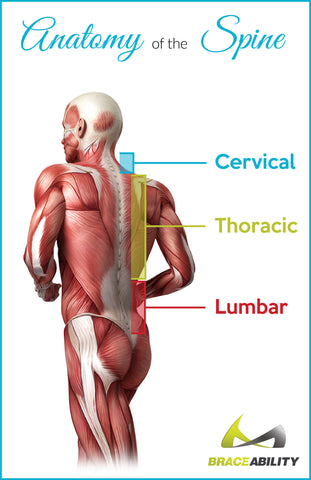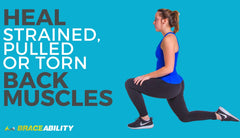Fractured Spinal Vertebrae
What is a Spine Fracture? Do I have a Broken Vertebrae in my Back?
There are a wide variety of different spinal fractures. Spinal fractures also vary in their level of severity. Some spinal fractures are extremely serious injuries that require emergency visits, while others may be caused by the weakening of bones or osteoporosis. Many severe spinal fractures occur from things like car accidents or high impact sports contact. A fracture of the vertebrae causes the bones to damage the spinal nerves or cords. To find out what kind of spinal fracture of the vertebrae you may have, continue reading.
What is The Anatomy of my Spine and Vertebrae?
To fully understand what a spinal fracture of the vertebrae is it is vital you understand the anatomy of your spine. Your spine is made up of a combination of nerves, bones, joints, tendons, ligaments, and muscles that all work together. The spine is designed to be both incredibly strong and flexible. Your spine is made up of 24 individual bones that are stacked on top of one another. To visualize the anatomy of your spine separate it into three distinct parts. The cervical spine in the neck, the thoracic spine which covers the majority of the upper to mid back, and the lowest portion being the lumbar spine that attaches to the sacrum. The spine is so important because it provides the main form of support for your body. Without it, you wouldn’t be able to stand upright, bend, or twist. Since the spine is so vital to the human body, any type of strain, injury, or illness can cause major issues.

Self Diagnosis: Which Kind of Spine Fracture Do I Have?
Vertebral Compression Fracture
A compression fracture of the spine occurs when your vertebrae, or bones of the spine, break. The most common cause of a vertebral compression fracture is osteoporosis of the spine.
I most likely have a vertebral compression fracture if:
My pain is located in between my T9 to L1 vertebrae. Most often people have L1 compression fractures and T12 compression fractures. This means that spinal compression fractures in the back most often occur in the lower thoracic spine and upper lumbar region. Thus, spinal compression fractures are often referred to as lumbar compression fractures and thoracic compression fractures. The major cause of a compression fracture is osteoporosis. Osteoporosis occurs when there is an imbalance between the new bone formation in your body and the old bone respiration. Essentially, your body may be failing at making new bones. Many compression fractures will be referred to as osteoporotic compression fractures. Click here to read more on osteoporosis.

Compression fracture symptoms:
Symptoms of vertebral compression fractures vary greatly, sometimes making it hard to identify. However, if you notice any of these symptoms that is a good indicator of a spinal compression fracture: acute back in between the T9 and L1, a noticeable hunchback called kyphosis, loss of height, crowding of internal organs, pain that worsens when you walk or stand, and difficulty bending or twisting.
Compression fracture treatments:
Thankfully, treatment for compression fractures is fairly conservative and treatable. The majority of treatment can happen through a combination of reducing your activities and medications. Conservative methods of treatment include activity modification for short periods of time, and back bracing to help limit motion of affected area - check out BraceAbility’s compression brace options here. Some people with severe cases may have to turn to surgery as the best option.
Read more on vertebral compression fractures.
Wedge Compression Fracture
A wedge compression fracture is similar to a vertebral compression fracture. However, a wedge fracture means that the vertebrae were fractured at the front of the bone in the front of the spine.
I most likely have a wedge compression fracture if:
The wedge compression fracture is in the thoracic spine. Wedge compression fractures occur anteriorly or laterally. Wedge compression fractures are most commonly anterior.
Wedge compression fracture symptoms:
Symptoms of compression fractures are very similar to symptoms of general compression fractures. However, they do affect the vertebrae in different ways so there is a difference.
Wedge compression fracture treatments:
Just like the treatment options for compression fractures, wedge fractures are essentially the same treatment methods. Refer to the above compression fracture treatments for conservative methods.
Burst Fracture
A burst fracture is very similar to a compression fracture or wedge compression fracture, only much more severe. However, a burst fracture is an injury to the spine when the vertebrae are severely compressed. If it’s crushed in the front of the spine, it is a wedge compression fracture, if the vertebrae are crushed in all directions, it is a burst fracture of the spine.
I most likely have a vertebral burst fracture if:
I have experienced severe and immediate trauma to my vertebrae. The leading causes of burst fractures include bad falls and car accidents. When a burst fracture occurs, the bones spread out in all different directions and may injure the spinal cord. Burst fractures are most common in your thoracic and lumbar spine. This means you will commonly hear of T12 burst fractures through L3 burst fractures.
Burst fracture symptoms:
The most common symptoms of a burst fracture include moderate to severe pain that gets much worse when moving, numbness and tingling in the back, and trouble emptying your bowel or bladder.
Burst fracture treatment:
A stable burst fracture may not require hospitalization or surgery. However, severe trauma burst fractures may require immediate hospitalization. If you think you’re suffering from a burst fracture, we recommend visiting with a doctor immediately for the right treatment methods.
Stress Fracture or Spondylolysis and Spondylolisthesis
A stress fracture of the back is called spondylolysis and is a common cause of lower back pain.
I most likely have a back stress fracture if:
Spondylolysis, or a lower back stress fracture, is most commonly caused by structural back pain in children, adolescents, and young adults. Spondylolysis refers to a defect of the bones of the spine known as the vertebrae. This defect is in the pars interarticularis, which is a small, bony arch toward the back of the spine. The most common form of the back stress fracture is in the L5 vertebrae. This means that stress fractures are commonly lower or lumbar back issues. Back stress fractures are also commonly known as spinal stress fractures, as they occur in the vertebrae.
Symptoms of a stress fracture in the back:
Symptoms of spondylolysis or lower back stress fractures usually include lower back pain. However, because this type of fracture can happen in your neck and mid back pain in those areas may be a symptom as well. Surprisingly, many people who have spondylolysis have no symptoms and may not even realize they have the condition. For those who do experience symptoms of spondylosis, it is usually spread around the lower back and feels similar to a muscle strain. The pain will likely increase with extreme exercise or activity. A physical exam, as well as a spondylolysis x-ray, can be used to diagnose this condition.
Stress fracture treatment:
The first line of defense for a lower back stress fracture is rest from any stressful activity. Often times people will also use a spondylolysis brace to provide support to the lower back while limiting one’s ability to move in a damaging way. Commonly people use anti-inflammatory medications as a recommended way to reduce the amount of pain and inflammation in your spine and back. Many people will also recommend physical therapy for stress fractures of the spine and back. The exercises used will focus on strengthening and improving the flexibility of your back and abdomen.
Cervical Fracture in your Neck
The cervical portion of your spine is your neck, as you can see in the above spine anatomy graphic. Most cervical fractures of the spine occur from a violent collision. A cervical fracture means that a bone is broken in the cervical spine (C1 through C7 vertebrae).
I most likely have a cervical fracture if:
I’m experiencing pain, tenderness, spasms, and swelling in my neck. Cervical fractures often make movement of the neck fairly difficult. Most people who suffer from a cervical fracture will have suffered from some kind of high impact conditions including motor vehicle accidents, falls, dives into shallow water, and injuries in contact sports.
Cervical fracture symptoms:
The most common cervical or neck fracture symptoms include pain and swelling in the neck region. Many people complain of trouble swallowing and numbness or tingling at the base of your head. It’s not uncommon for people to have trouble with their vision or experience a pin prick pain in other places of their bodies (arms, legs, etc).
Is There A Difference Between A Break Vs. Fracture?
This is one of those commonly misunderstood medical questions. There is no difference between a break and a fracture. Above you may have heard us refer to both breaks and fractures. When we say fracture we mean break and vice versa. A fracture is any loss of continuity of a bone which is also considered a break.
Can You Break Multiple Vertebrae At A Time?
Yes, it is possible to break more than one vertebrae at a time. In fact, it’s common when you suffer from a compression fracture to break more than one. Often times you become at higher risk for a subsequent fracture. If you have multiple fractures in your spine your symptoms will most often be a loss of height, or potentially even suffering from a condition called kyphosis.




